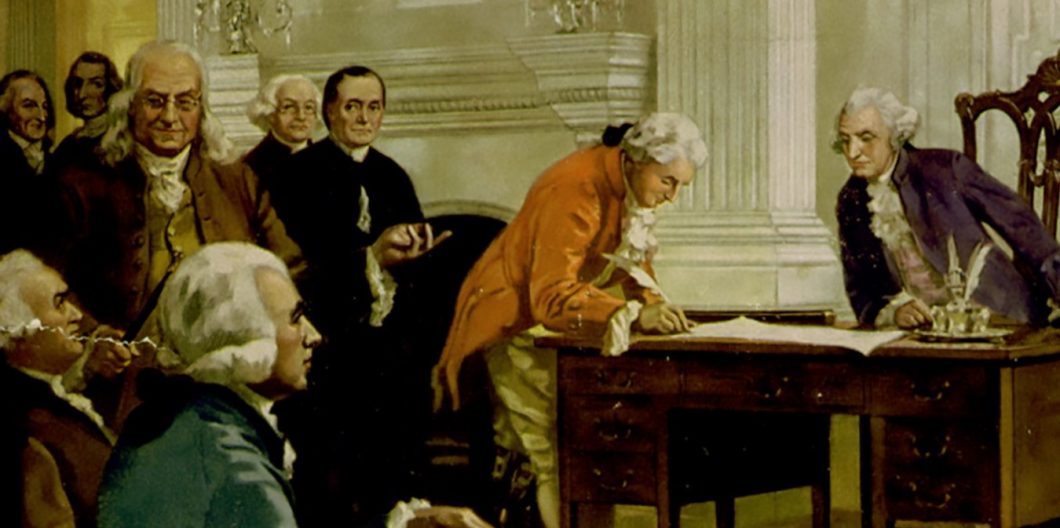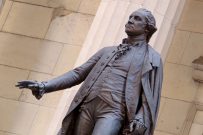Instead of thinking politically about philosophy we should be thinking philosophically about politics.
Akhil Amar's 1789 Project
One of the greatest American historians recently remarked to me that it was difficult to staff undergraduate survey courses on the American founding because relatively few contemporary historians were interested in the subject, and those few generally wanted to consider it only from the narrow perspective of race or gender. It is thus perhaps not surprising that the best book on the subject in many years comes not from an academic historian but a law professor—Akhil Reed Amar of Yale University. In The Words That Made Us: America’s Constitutional Conversation 1760-1840, Amar offers a fresh look at the ideas that shaped the Revolution, constitutional framing, and early republic, arguing against old reductionists like Charles Beard, who claimed that the Constitution was a coup of elitists against democracy, and new reductionists like those behind the 1619 project, who now claim that the Revolution was in part an effort to preserve slavery. Instead, Amar sees our early history as propelled by debate about general government ideals, where concepts such as sovereignty evolved through argument and Americans’ lived experience.
The Founding Conversation
This book is a temporal extension of the method of Bernard Bailyn’s Ideological Origins of American Revolution into the rest of the founding period and beyond. But it also represents an expansion of Bailyn’s method of mapping, through careful analysis, the dialectical evolutions of key political concepts. Amar considers three important dynamics that help explain why the founding turned out the way it did: the cultural context which made written argument so central to early America, the visual symbols with which Americans popularized the central propositions of their social movements, and the rational choices that the constraints of their situation dictated.
First, Amar is not using the term “conversation” in his subtitle metaphorically. He argues that the literacy of the colonists and their growing culture of journalism and pamphleteering pushed debate over political ideas to the forefront of daily popular discourse. As a result, Americans were carried along by the logic of legal and constitutional argument to an extent unmatched in human history. These ideals mattered to the way citizens viewed the world beyond considerations of material circumstance and exigencies of fortune.
Second, Amar has a wonderful sense of the iconography of the period. He shows, for instance, how Benjamin Franklin’s woodcut of a snake segmented into different colonies with the exhortation “Join or Die” “went viral.” The simple image made clear even to those not versed in the complexities of argument that the colonies had to unite in confederation against Britain or be cut up into little pieces. Visual memory was also long-lasting. Amar notes that the same famous cartoon of coffins that Paul Revere used to memorialize the Boston massacre was used decades later to lambast Andrew Jackson for executing militiamen under his command and suggest that he was a “bloodthirsty military man reminiscent of British military brutes.” Amar also provides images of key Founders, showing how attentive they became to their image in a democratic society. Jefferson in particular changes his presentation of himself from elegant aristocrat to man of the people.
Third, Amar demonstrates how developments in the period unfolded according to common constraints as well as a common ideology. He is superb in showing the underlying rational choice logic of the Constitution—the pivotal event of our republic. The overwhelming problem of the Articles of Confederation was that that they were inadequate for national defense. The national government could not directly raise an army but had to depend on the state requisitions, leading to a free-rider problem: Every state had an incentive to shirk in the hope that the rest would provide the necessary muscle.
But in creating a federal government powerful enough to fund and command an army, the Framers were obliged by their ideology of “no taxation without representation” to make it representative of the people, not just the states. Thus, the creation of the House of Representatives. The federal judiciary also became necessary to superintend state law, making sure it did not interfere with the national government that was so necessary to defense. I would add that any judicial review is natural to a system of federalism and separation of powers because there needs to be a referee for the disputes. The Framers were fine statesmen, but Amar’s account suggests a substantial inevitability to the basic design of the Constitution. The basic shape of our fundamental law was generated by geostrategic necessity refracted through the concepts of popular sovereignty.
Our Washington
Of the many contributions the book makes to our understanding of the early republic, the most original is to show that Washington was not only the father of the country but of the Constitution. The biggest change from the Articles—“its breathtakingly strong chief executive, by American Revolutionary standards”—was due to Washington. Washington wanted an institutional structure that could win another war and, better yet, deter potential enemies. And the Framers were only able to make this pivotal structural change because everyone was confident in the man—Washington—that they all knew would be the first and precedent-setting President. Moreover, Washington’s letter transmitting the Constitution to the Continental Congress was very influential just because his name was on it.
In contrast, James Madison, often called the Father of the Constitution, failed to get his key recommendations into the Constitution, like a congressional veto on state legislation. His now famous theoretical contribution to the ratification debate in Federalist No. 10 was completely ignored at the time. Instead, the most influential Federalist essays were those of Hamilton and Jay that stressed the need for unity and unified military command in a dangerous world—a defense of Washington’s strategic vision.
Jefferson and Adams represent the polarities of democratic enthusiasm and overconfident elitism. A great statesman must avoid both.
More generally, Washington comes off as indisputably deserving of the refrain, “First in War, First in Peace, First in the Hearts of His Countrymen.” Even in death, he, unlike Madison and Jefferson, not only manumitted his own slaves but paid for their upkeep. This was a substantial cost to his estate. Fittingly for a man of action, his final message to his fellow citizens was through a selfless deed on behalf of liberty. Amar’s book should remind everyone of why it is right that statutes of Washington are planted thickly through the continent. He was America’s prime mover. To cancel him is to repudiate its creation.
Parallel Lives
The Words That Made Us is a welcome throwback to ancient historians like Plutarch because it is full of moral judgments—in this case about the relative merits of various founders. While all are well-argued, not all are as persuasive as Amar’s prioritization of Washington. In the perennial debate about the worthiness of Jefferson versus Adams, Amar comes down strongly on Jefferson’s side. According to Amar, Adams was an egotist, always concerned about Adams, and so distrustful of popular sentiment that he backed the Alien and Sedition Acts, against which Amar mounts a fine constitutional indictment. All too true. But Jefferson, as Amar himself notes, became more favorable to slavery as time went on, despite likely having fathered children with a woman he kept enslaved. And his attacks on the Alien and Sedition Acts were not as much rooted in an analysis of the First Amendment as in a claim of the authority of the states to interpose their own judgments of constitutionality, a claim that would ultimately help splinter the republic. Most relevant to law, John Adams appointed the greatest Chief Justice ever, but Jefferson wanted to neuter the Supreme Court. Jefferson also had a naïve view of the French Revolution, the foreign epochal event of the time, and a false conception of human nature, which he saw as much more malleable than it is. In my view, Jefferson and Adams represent the polarities of democratic enthusiasm and overconfident elitism. A great statesman must avoid both.
Amar also provides masterful discussions of important Supreme Court cases, including well known ones like Marbury v. Madison, and now obscure ones like United States v. Hudson and Goodwin, which held that there was no federal law of crimes. He is also excellent in elucidating complicated legal concepts like the writs of assistance, which were at the heart of the famous colonial Paxton’s Case, which Adams trumpeted over dramatically as the event “where the Child of Independence was Born.”
Constitutional Meaning
Yet my most substantial reservations about Amar’s book concern a few of his legal claims. He argues that the Constitution was written in “plain language,” emphasizing its democratic transparency. But as Mike Rappaport and I have shown, the Constitution is full of legal terms and, indeed, includes references to legal rules as in the non-obstante phrasing in the Supremacy Clause. The Constitution is a document designed to create government for the people, but it is emphatically not a document transparent in every respect to a reader unfamiliar with law. In fact, the Constitution could be so short in part because its legal context amplified its content.
Amar himself notes that the debates over breaking away from Britain bristled with legalisms. That same sophisticated, legalistic culture produced the Constitution, even as early America had a parallel culture, including that of visual iconography, to help the less educated understand the principal propositions, if not all the details, of governance.
I also believe it may be unfair to Madison when Amar says that his signing of the bill reauthorizing the Bank of the United States after previously arguing that it was unconstitutional shows political expediency. Madison had a theory of constitutional liquidation, in which matters that may have been unclear become settled by practice. He also held the view that Supreme Court precedent should be treated as particularly authoritative, because justices were more disinterested than politicians. Thus, Madison did have principled reasons to change his position. Like most statesmen, his motives were likely mixed.
But these criticisms are small points considering the magnitude of Amar’s achievement. He has written a book both popular and learned, one that is fast-paced enough to hold the attention of the general reader and yet makes enough new points about fundamental matters to engage the serious scholar. And it comes a critical time. Amar shows why the Founding and the early republic deserve our continued respect even if many of the great men responsible for its creation had flaws of character and moral blind spots, as do we all. It a book not only of a scholar but a patriot. If widely read, it may make the difficulty of finding appropriate professional historians to teach our children less of a threat to our common future.


